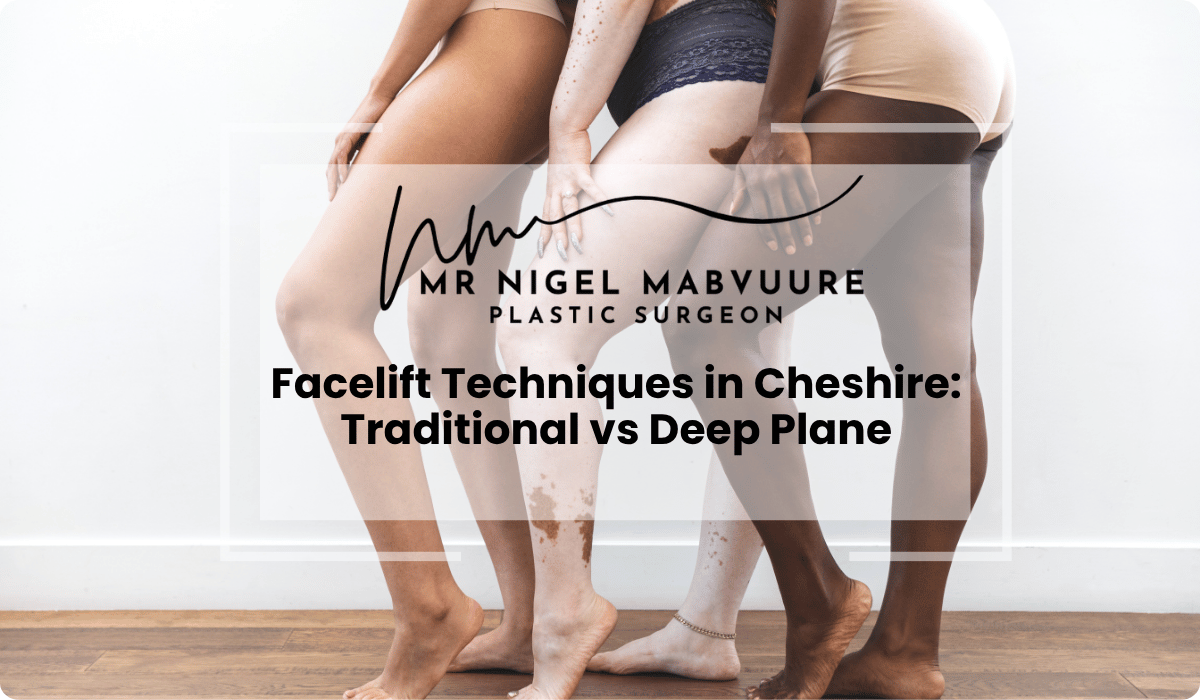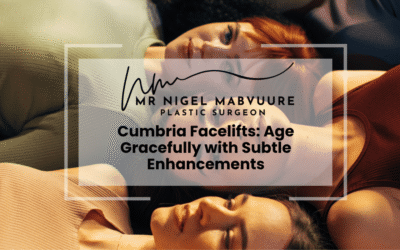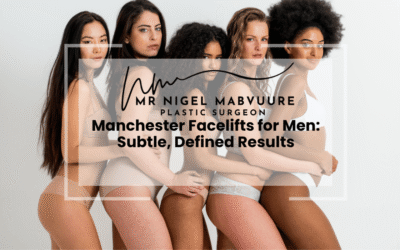- Traditional facelifts primarily address the lower face and neck with results lasting 7-10 years, while deep plane facelifts provide more comprehensive rejuvenation including the midface with results lasting 10-15 years.
- Deep plane techniques create more natural-looking, three-dimensional results by repositioning tissues vertically and laterally, avoiding the “windswept” appearance sometimes associated with traditional methods.
- The ideal facelift technique depends on individual factors including age, facial anatomy, specific concerns, recovery preferences, and budget considerations.
- Recovery from deep plane facelifts typically involves more initial swelling but potentially less bruising than traditional approaches, with most patients resuming normal activities after 2-3 weeks.
- When selecting a surgeon in Cheshire, look for credentials from BAAPS or BAPRAS, extensive experience with your desired technique, and a personalised approach to facial rejuvenation.
Table of Contents
- Understanding Modern Facelift Techniques in Cheshire
- Traditional Facelift Methods: Procedure and Results
- What is a Deep Plane Facelift and How Does it Work?
- Comparing Traditional vs Deep Plane Facelift Outcomes
- Which Facelift Technique is Best for Your Specific Needs?
- Recovery and Aftercare: Differences Between Techniques
- Finding Expert Facelift Surgeons in Cheshire
- The Future of Facial Rejuvenation Procedures
Understanding Modern Facelift Techniques in Cheshire
The landscape of facelift techniques in Cheshire has evolved dramatically over the past decade, offering patients more specialised options than ever before. Modern facelift procedures have moved beyond the one-size-fits-all approach to address specific ageing concerns with precision and customisation. For residents in Cheshire seeking facial rejuvenation, understanding the differences between traditional and advanced techniques like the deep plane facelift is essential for making informed decisions.
Today’s facelift techniques focus on creating natural-looking results that avoid the telltale signs of surgery. The most significant advancement has been the shift from simply tightening skin to addressing the underlying structural changes that occur with ageing. This fundamental change in approach has revolutionised outcomes, particularly in how surgeons address the midface, jawline, and neck regions.
Cheshire clinics now offer a spectrum of facelift techniques, ranging from minimally invasive procedures to comprehensive surgical interventions. Each technique varies in its approach to tissue manipulation, incision patterns, and target areas. The choice between traditional methods and newer approaches like the deep plane technique depends on factors including age, skin quality, facial anatomy, and desired outcomes.
Traditional Facelift Methods: Procedure and Results
Traditional facelift methods, often referred to as SMAS (Superficial Musculo-Aponeurotic System) facelifts, have been the standard approach for decades in Cheshire and worldwide. This technique focuses on tightening the SMAS layer, which is a sheet of tissue that covers the deeper facial structures and connects to the facial muscles. The procedure typically begins with incisions made around the temples, continuing around the ear and potentially extending into the lower scalp.
During a traditional facelift, the surgeon separates the skin from the underlying SMAS layer, then tightens and repositions this layer before re-draping the skin and removing any excess. This approach effectively addresses sagging in the lower face and neck, improving jowls and creating a more defined jawline. The procedure usually takes 2-4 hours and is performed under general anaesthesia or deep sedation with local anaesthesia.
Results from traditional facelifts typically last 7-10 years, with patients experiencing significant improvement in the lower third of the face. However, traditional techniques may not address midface sagging as comprehensively as newer methods. The recovery period generally spans 2-3 weeks, with residual swelling potentially lasting several months. While effective, traditional methods sometimes receive criticism for creating a “windswept” appearance if the skin is pulled too tightly or if the deeper tissues aren’t adequately addressed.
What is a Deep Plane Facelift and How Does it Work?
The deep plane facelift represents an advanced evolution in facial rejuvenation techniques available in Cheshire. Unlike traditional methods that work primarily on the skin and superficial layers, the deep plane approach targets the deeper structural elements of the face. This technique involves releasing and repositioning the deeper facial tissues as a single, cohesive unit, creating more natural-looking results with longer-lasting effects.
During a deep plane facelift, the surgeon works beneath the SMAS layer, releasing key ligaments that, when tightened with age, contribute to facial sagging. By operating in this deeper plane, the surgeon can reposition facial fat pads, muscles, and other tissues to their more youthful positions. This comprehensive approach addresses not only the lower face and neck but also the midface region, including the nasolabial folds (smile lines) and cheek area.
The procedure begins with similar incisions to traditional facelifts but differs significantly in the dissection technique. Rather than separating the skin from underlying tissues, the surgeon elevates both the skin and SMAS layer together, preserving the vital connections between these layers. This preservation of the natural tissue relationships and blood supply contributes to better healing, reduced risk of skin necrosis, and more natural movement of facial expressions post-surgery. For patients with significant midface sagging or those seeking comprehensive facial rejuvenation, the deep plane technique offers distinct advantages over traditional approaches.
Comparing Traditional vs Deep Plane Facelift Outcomes
When evaluating facelift techniques in Cheshire, the outcomes between traditional and deep plane approaches show notable differences that prospective patients should consider. Traditional facelifts typically deliver excellent results for the lower face and neck, effectively addressing jowls and neck laxity. However, these results may appear somewhat two-dimensional, as the technique primarily works by pulling tissues backward rather than lifting them vertically.
Deep plane facelifts, by contrast, often produce more three-dimensional rejuvenation. By releasing key facial ligaments and repositioning tissues vertically as well as laterally, this technique can restore volume to the midface while simultaneously improving the jawline and neck. Patients typically report that deep plane results appear more natural and less “surgical” because the technique avoids the skin tension that can create a tight or pulled appearance.
Longevity represents another significant difference between these approaches. While traditional facelifts generally last 7-10 years, deep plane results often extend to 10-15 years due to the more comprehensive tissue repositioning. This extended longevity makes the deep plane approach particularly appealing for younger patients seeking preventative intervention or those wanting to maximise their surgical investment. Natural-looking results are achievable with both techniques when performed by skilled surgeons, though the deep plane method may offer superior outcomes for patients with significant midface sagging or those seeking comprehensive facial rejuvenation.
Which Facelift Technique is Best for Your Specific Needs?
Determining the optimal facelift technique for your specific needs requires careful consideration of several factors. Age plays a significant role in this decision-making process. Patients in their 40s to early 50s with early signs of ageing may benefit from less invasive traditional approaches, while those with more advanced ageing changes might achieve more comprehensive improvement with a deep plane facelift. The specific areas of concern also guide technique selection—traditional methods excel at addressing the lower face and neck, while deep plane approaches offer superior correction for midface sagging and nasolabial folds.
Facial anatomy represents another crucial consideration. Patients with thinner faces and less subcutaneous fat often benefit from deep plane techniques that avoid placing tension on delicate skin. Conversely, individuals with good skin elasticity and primarily lower face concerns might achieve excellent results with traditional methods. Recovery considerations should also factor into your decision, as traditional facelifts typically involve somewhat shorter recovery periods compared to deep plane procedures.
Budget considerations cannot be overlooked, as deep plane facelifts generally command higher fees due to their technical complexity and the advanced expertise required. However, their longer-lasting results may offer better value over time. The most reliable way to determine which technique best suits your needs is through consultation with experienced Cheshire facelift surgeons who can evaluate your unique facial structure, discuss your aesthetic goals, and recommend the most appropriate approach for achieving natural-looking rejuvenation.
Recovery and Aftercare: Differences Between Techniques
Recovery experiences differ notably between traditional and deep plane facelift techniques, though both require dedicated aftercare for optimal results. Traditional facelift recovery typically involves moderate swelling and bruising that peaks around days 3-4 post-surgery. Most patients can return to light social activities within 10-14 days, though complete healing may take several weeks. Initial tightness and numbness are common but generally resolve within the first month.
Deep plane facelift recovery often involves more significant initial swelling due to the more extensive tissue manipulation, though some surgeons report less bruising due to the preservation of natural tissue planes and blood supply. The recovery timeline typically extends slightly longer than traditional approaches, with most patients resuming normal activities after 2-3 weeks. Despite the potentially longer initial recovery, deep plane patients often experience less prolonged tightness and more natural movement as healing progresses.
Aftercare protocols share similarities across techniques but may be more intensive following deep plane procedures. All facelift patients should keep their head elevated, apply cold compresses as directed, avoid strenuous activities for at least 3-4 weeks, and attend all follow-up appointments. Surgeons typically remove sutures between 5-10 days post-surgery, regardless of technique. Both approaches require sun protection and scar care, though deep plane incisions may be slightly more extensive in some cases. Patients should understand that final results from either technique continue to improve for up to 6 months as residual swelling resolves and tissues settle into their new positions.
Finding Expert Facelift Surgeons in Cheshire
Selecting the right surgeon is perhaps the most critical decision when considering facelift techniques in Cheshire. The technical expertise required for successful outcomes—particularly for advanced procedures like deep plane facelifts—cannot be overstated. Begin your search by verifying credentials and specialisations. Look for surgeons who are members of the British Association of Aesthetic Plastic Surgeons (BAAPS) or the British Association of Plastic, Reconstructive and Aesthetic Surgeons (BAPRAS), which indicates adherence to strict ethical and professional standards.
Experience specifically with your desired technique is essential. When researching potential surgeons, inquire about how many facelifts they perform annually and their experience with both traditional and deep plane approaches. The best practitioners will have extensive portfolios of before-and-after photos demonstrating consistent, natural-looking results across diverse patient types. During consultations, assess whether the surgeon takes time to understand your specific concerns and explains which technique would best address your unique facial anatomy.
Cheshire offers several reputable clinics specialising in facial rejuvenation, particularly in areas like Alderley Edge, Wilmslow, and Chester. Patient reviews and testimonials provide valuable insights into the surgical experience and results. Be wary of surgeons who push a single technique for all patients, as this suggests a lack of versatility. The ideal facelift surgeon will offer a personalised approach, recommending the specific technique—whether traditional or deep plane—that will best achieve your aesthetic goals while considering your recovery preferences and anatomical characteristics.
The Future of Facial Rejuvenation Procedures
The landscape of facelift techniques continues to evolve rapidly, with Cheshire clinics at the forefront of adopting innovative approaches. Current trends suggest a movement toward more customised combinations of techniques, where surgeons might employ deep plane methods for the midface while using traditional approaches for the neck, creating truly bespoke rejuvenation plans. This hybrid approach allows for targeted correction of specific ageing patterns while minimising recovery time and maximising natural-looking results.
Technological advancements are significantly influencing facelift procedures. Enhanced imaging systems now allow surgeons to visualise facial anatomy with unprecedented precision, while specialised instruments facilitate more accurate tissue manipulation. Some Cheshire clinics have begun incorporating adjunctive treatments like platelet-rich plasma (PRP) or stem cell therapies during facelift procedures to enhance healing and potentially improve long-term tissue quality. These biological approaches represent an exciting frontier in facial rejuvenation.
Looking forward, the distinction between traditional and deep plane techniques may become less rigid as surgeons develop more nuanced approaches tailored to individual facial ageing patterns. The trend toward less invasive procedures continues alongside refinements in traditional surgical techniques, giving patients more options across the intervention spectrum. As our understanding of facial ageing becomes more sophisticated, techniques will likely continue to evolve toward addressing not just tissue laxity but also volume loss, skin quality, and the dynamic nature of facial expressions. For Cheshire residents considering facial rejuvenation, this progressive landscape promises increasingly natural, harmonious, and long-lasting results.
Frequently Asked Questions
What is the main difference between a traditional facelift and a deep plane facelift?
The main difference lies in the surgical approach and tissue manipulation. Traditional facelifts primarily work on the skin and SMAS layer separately, focusing on the lower face and neck. Deep plane facelifts work beneath the SMAS layer, releasing facial ligaments and repositioning tissues as a cohesive unit, addressing both the lower face and midface region. Deep plane techniques typically produce more three-dimensional results with longer-lasting effects (10-15 years versus 7-10 years for traditional methods).
How long is the recovery period after each type of facelift?
Traditional facelift recovery typically allows return to light social activities within 10-14 days, with moderate swelling and bruising peaking around days 3-4. Deep plane facelift recovery often involves more initial swelling and generally extends slightly longer, with most patients resuming normal activities after 2-3 weeks. Both techniques require avoiding strenuous activities for 3-4 weeks, with final results continuing to improve for up to 6 months as residual swelling resolves.
Which facelift technique is best for addressing midface sagging?
The deep plane facelift technique is superior for addressing midface sagging. By releasing key facial ligaments and repositioning tissues vertically as well as laterally, this approach effectively restores volume to the midface area and improves nasolabial folds (smile lines). Traditional techniques are less effective for midface concerns as they primarily focus on the lower face and neck regions through a more horizontal vector of lift.
Are deep plane facelifts more expensive than traditional facelifts in Cheshire?
Yes, deep plane facelifts generally command higher fees than traditional facelifts in Cheshire due to their technical complexity and the advanced expertise required to perform them safely and effectively. However, many patients consider them better value over time due to their longer-lasting results (10-15 years compared to 7-10 years for traditional methods) and more comprehensive rejuvenation of multiple facial areas.
How do I know which facelift technique is right for me?
The best technique depends on your age, facial anatomy, specific concerns, and desired outcomes. Younger patients (40s-early 50s) with early signs of aging may benefit from traditional approaches, while those with significant midface sagging or more advanced aging changes might achieve better results with a deep plane facelift. Consultation with experienced Cheshire facelift surgeons who offer multiple techniques is essential for personalized recommendations based on your unique facial structure and aesthetic goals.
What qualifications should I look for in a Cheshire facelift surgeon?
Look for surgeons who are members of the British Association of Aesthetic Plastic Surgeons (BAAPS) or the British Association of Plastic, Reconstructive and Aesthetic Surgeons (BAPRAS). Verify their specific experience with your desired technique, including how many facelifts they perform annually. Review their before-and-after portfolios for consistent, natural-looking results. The ideal surgeon will offer personalized recommendations rather than promoting a single technique for all patients.




